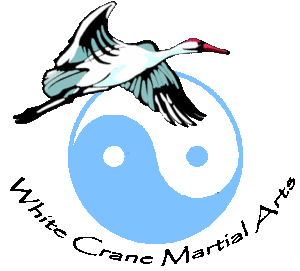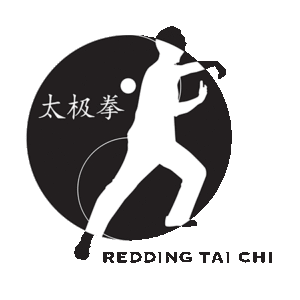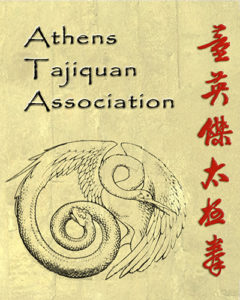Slanted FlyingJournal of Tai Chi Chuan
Training
Lessons from Taijiquan Interactive Weapons Practice
Because of the single edge of the saber, it can be used rather close to the body (even touching it in many common techniques, like coiling around the body or supporting its back with the free hand or forearm) as well as at fairly long range, but the sword has both edges sharp and is, therefore, difficult to use close to the body. The range of usage for the sword is therefore typically farther away from the body.
The metal of the sword slides more than flesh does, which makes controlling the opponent and their weapon, through one’s own weapon, more difficult than with the hands. The sharpness of the edges means that an opponent can be easily cut without requiring great power.
The emphasis with the sword is often on deflecting the opponent’s weapon in order to create openings for counterattacks, or in pivoting the sword around the obstacles presented by the opponent’s weapon. Although the sword frequently remains in contact with the opponent’s weapon, it is not unusual for the practitioner to break contact in order to attack through an opening in the opponent’s defenses.
Because of the emphasis on pivoting, the sword grip typically requires more flexibility and changeability than the saber grip. With the sword, the hand/wrist creates another joint between you and the opponent.
The saber and sword are the primary short weapons, and weapons like fan, dagger, stick, cane, flute, fly whisk, and umbrella can be adapted to use saber or sword techniques. The primary long weapons are staff and spear.
The staff (棍 gun) would be the next weapon to learn based on the wuxing creative cycle (Water nourishes Wood). The staff is associated with whirlwinds and whirlpools due to the spinning nature of using both ends.
As I learned it, the staff should be about a fist’s width longer (about 3”) than a practitioner is tall. It is usually made of a resilient wood, commonly rattan or white wax wood (白蜡杆 baila gan). Because of its resiliency and a grain that runs the length of the weapon, practitioners should learn to sense the opponent’s weapon through the staff.
I have been unable to find online the Taiji staff sparring form that I learned, but the following solo form shows a routine that holds the staff in thirds, rather than having one hand on the butt (like a spear is held):
The following translation contains Taiji pole (桿 essentially a spear without the metal point) usage drills similar to what I was taught for staff, although ours would be held in thirds rather than as shown:
TAIJI SPEAR METHODS ACCORDING TO CHEN YANLIN
This video shows some free sparring with staffs:
When held primarily in thirds, with usage frequently switching ends, the staff teaches the linkage and coordination between the hands and the connection through the body, and therefore the rotation of the spine is emphasized. The staff has a center that is between your hands, and this should be unified with the practitioner’s center at the lower dantien (丹田 elixir field). Because the staff is not sharp, power needs to be transmitted to the striking end.
When a practitioner is comfortable using the staff in thirds, they can begin to adjust the grip such that the forward end is longer. This can be seen in the free sparring video.
Because a hand is often within range of the opponent’s weapon, the ability to change into several versions of a half-grip, that protects it as the opponent’s weapon slides past, is important. The full grip is also changeable, sometimes being firm when power or structure is required, but can also be loose and allow the staff to slide or rotate within the guiding full grip.
Taiji spear (鎗 qiang) would be learned next according to the creative cycle of the wuxing (Wood feeds Fire). Unfortunately, I have not learned a spear sparring set. The drills that I learned are nearly identical to those given above for the pole.
Spear is associated with a dragon’s tongue since its usage involves very fast thrusts and retreats, like the tongue, at the tip of the powerful dragon, flicking in and out. While the butt end is sometimes used, the emphasis is on the spear point. Unlike the staff, the sharp point can cut and pierce an opponent, and the range is greater since the spear is usually held with one hand on the butt.
The standard length for the spear is from the floor to the middle finger of the hand raised naturally straight up above the shoulder. Because of the range of the spear, the opponent’s foot is often targeted in places where the shorter staff typically would target the knee/leg. Also because of its length and resiliency, the spear end can be whipped around and can be used to powerfully knock aside an opponent’s weapon, creating openings to dart through.
Being the longest of the standard weapons, and needing the power to travel all the way to the tip, the spear needs power and energy to extend the farthest outside the body. This makes it a good tool for training fajin (發勁 issuing energy, typically with explosive force). A pole or spear that is longer than the standard spear length is often used to develop fajin. If using a spear, the tassel, along with ball bearings inside the tip that make sounds during the practice, can help practitioners sense the quality of their energy projection.
Weapons are not only fun ways to vary one’s practice, but also have interesting characteristics that can improve a practitioner’s overall skill level. The wuxing has Fire producing Earth, and weapons work should improve weaponless skills. We want to be able to harmonize with the weapon and its characteristics in a way that borrows the weapon’s strength. In a way, this is following the weapons rather than imposing movements on them. Practice with weapons will not only strengthen the body due to their weight, but it should also feel easier when one learns to harmonize their movements with the weapon.













